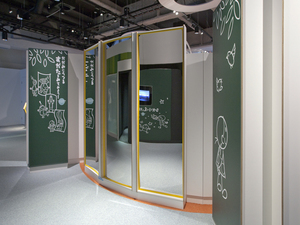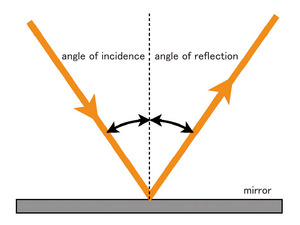Nagoya City Science Museum
TOP > Exhibition Guide > Floor Map> Amazing Mirrors
Amazing Mirrors



Purpose of Exhibition
Various shaped mirrors exhibited here show you amazing images by reflection of light. Enjoy looking at mirror images to be inspired to learn more about light.
Additional Knowledge
[Reflection of Light and Images]
The phenomenon where light is bounced back onto an object's surface is called "reflection". When light is reflected, angles of light ray approaching (incident light) and reflected (reflected light) are equal (figure). Then, reflection on flat surfaces such as mirrors and buffed metals creates "images" same shape as the actual object.
[Change of Reflection Surface Shape Changes the Vision]
When the shape of a mirror's surface is curved, it's possible to change the image size.
For example, a mirror which has a curved outside reflective surface (a convex mirror), the image becomes small. However, it is used for curved mirrors and rearview mirrors of cars because it is possible to reflect landscape over a wide range in just a small area.
On the other hand, when we look closely at a mirror where the curved inside surface is the reflector (concave mirror), the image becomes big. However, when you look at it from a distance, the top and bottom and left and right sides become opposite, and look small. Please try it with a clean spoon. In a concave mirror, there is a focus where reflected light gathers in one point and the image changes whether the viewing place is in front of it or behind it.
Because of this, changes in the reflection surface shape mean a change of direction of the reflected light. If the surface of the mirror is bent in a complicated manner, the image becomes spread out and shrinks, and it appears distorted.
[Combine Plural Mirrors]
It is possible to make many images when combining plural mirrors for use. Triple mirrors and kaleidoscopes are samples. Reflecting mirrors are also a trick with plural mirrors put together. It would be interesting to think about how light direction travels and observe it.
By the way, a mirror made of 3 plane mirrors combined at right angles to each other in the shape of a triangular pyramid is called a "Corner Reflector". If light is allowed to enter, it is always reflected in the entered direction. Using this effect, it is used for light reflectors installed in bicycles and roadways. That's why it shines when it is illuminated by headlights, though it doesn't emit light on its own. When Apollo landed on the surface of the moon, a corner reflector mirror was installed there. It was used to measure the correct distance between the moon and the earth by radiating a laser light from the earth and making it reflect.
[Various Mirrors in this Exhibit]
Here is a list of the names of mirrors and their mechanisms in this exhibit, and how they work is described below.
(1)Handshaking MirrorThis is one piece of concave mirror. Since it reflects upside down, when you put your hand out, you can see your reflected hand 'handshaking' from the opposite side.
(2) Reflecting MirrorsThis is a triangular pyramid made with 3 plane mirrors. If you put your hand in the window which cut the top of the triangular pyramid and see it from the opposite side, you can see many hands as if they are multiplying.
(3)Transparent MirrorsThere are some pillars that are put up at right angles to each other, like the shape of the "Ku" of the hiragana character. They consist of thin plane mirrors and reflect both sides. You can see the things on the other side of the mirror reflected as if the mirror is transparent.
(4)Chasing MirrorsThree plane mirrors are at the right angles to each other like the corners of dice (Corner reflector). Because reflected light leaves in the same direction as incident light, you can see your face staring at you from wherever you peer inside.
(5)Transformational MirrorsThese are three kinds of mirrors with various curved surfaces. They reflect you thin, fat, stretched, or shrunk.
(6)Reverse MirrorsTwo plane mirrors are put at right angles to each other. It is different from one mirror, and left and right are reflected opposite each other.
(7)Cannot Grab?Two concave mirrors are combined up and down. The objects which are put on the middle of the lower mirror seem to be floating and you cannot grab them even if you try to.
Article by: Shoji Nishimoto, curator
